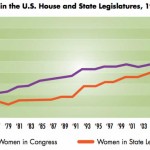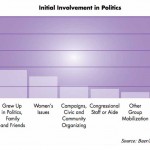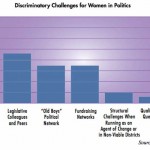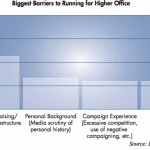By Nia-Malika Henderson
Published May 22, 2014
Dig out your crystal balls and consider this: Predictions for when women will reach politically parity are right in line with predictions for when humans will start setting up colonies on the moon.Now at about 20 percent of overall representation, women won’t reach parity in electoral politics until 2121.
(Nine years later perhaps they will govern from the moon?)
A new report called “Shifting Gears: How Women Navigate the Road to Higher Office” looks at, why, after all these years, women are still under-represented in elected office and why it’s going to take so long to reach equal representation.
Released by Political Parity, a non-partisan group that aims to increase the number of women in elected office, the report is a survey of about 200 women who are involved in politics, as candidates, aides and officials and gets at why they run and what they face when they do decide to run.
The results reveal a complicated landscape for women in politics, with discrimination and bias impeding progress, and other social, cultural and political barriers as well. For instance, only 18 percent of the state legislators who were surveyed said they have seriously considered running for a higher office.
So, in this election season, in which women are the most coveted voting bloc and women candidates are engaged in high-profile campaigns for the Senate and other statewide races, where do things stand and where are they headed?
Here are a few charts from the report:
1. The purple line says it all. In Congress, progress has essentially flat-lined over the last five or six years. At the state level, after years of little progress, there has been an uptick. These two trend lines are related of course–state legislatures are the perfect feeder system for Congressional candidates, which is why Republicans and Democrats have started to expand their efforts to focus on growing the bench of women candidates at the state level. But that will be a slow process.
2. And what about the women who do run? How do they end up with their name on the ballot? By far, the respondents said issues pushed them to run. But the second most listed reason–grew up in politics–is also interesting in light of this midterm.The women who are out front this go round (and in 2016 should Hillary Clinton run), are from political families. Michelle Nunn in Georgia. Shelley Moore Capito in West Virginia. Alison Lundergan Grimes in Kentucky. Mary Landrieu in Louisiana. Historically, women have often entered politics because of their husbands–the first woman governor Nellie Davis Tayloe of Wyoming, assumed the office after her husband died. Being from a political family offers a ready-made base of support and infrastructure, particularly financial, that makes it easier for women to run.
3. There is a reason why the projections for parity are a century away. Women candidates face wholesale barriers both in their own parties and in terms of how they are viewed and covered by the press.
4. The average cost of a U.S. Senate campaign is a $10 million. And a run for House seat runs about $1.7 million, according to Federal Elections Commission data. And those numbers will likely grow as more money floods the process. Some women running for office can raise as much money as men, but it often takes more asks to get to the same number. And according to the survey, women expressed some unease with the asking process. As well, women are less likely to have the kind of established networks that running for higher office demands of candidates.
5. This chart brings to mind two people–Hillary Clinton and Alison Lundergan Grimes. Clinton famously eschewed playing what might be called “the gender card” in 2008, yet polls suggest that she might want to try a different strategy should she run in 2016. As for Grimes, she is going big on gender, touting herself as a “strong Kentucky woman,” as she faces off against Mitch McConnell in Kentucky. Clinton, in 2008, “worked within gender norms” in the language of this poll, yet the question is are we seeing a shift in existing norms? When the dust of 2014 is settled, there will be lots of pontificating about what the results mean as far as gender.
Latest posts by Nudge Domain Admin (see all)
- The REIT - January 9, 2015
- Second Women In Leadership Africa Forum And Awards In East Africa - January 1, 2015
- A Hobby or a Business? - December 19, 2014






12 thoughts on “Women will reach political parity in 2121. Why will it take so long?”